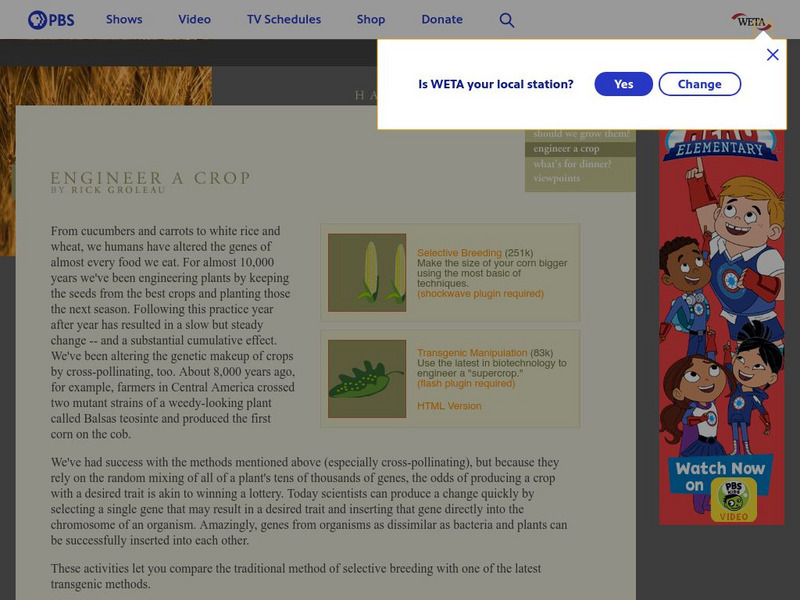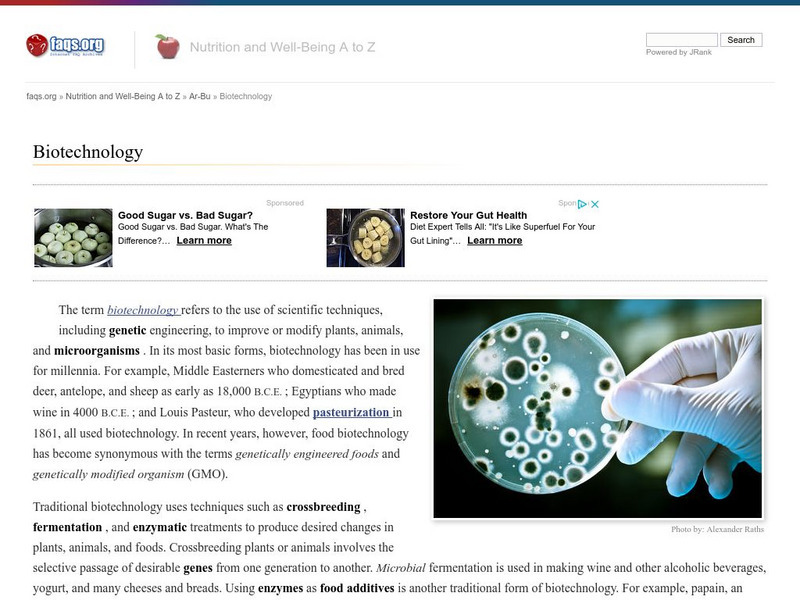Curated OER
Cotton and Cabbage
High schoolers note how given traits could be achieved by selective breeding and by transgenesis. They identify different uses of GEO. Students recognize that the use of letters (Bt) before an organism's name means that the organism has...
Curated OER
Science: Designer genes
Students engineer new organisms using biotechnology. In small groups, they write procedures, list benefits and drawbacks, and explain how their new organism might affect the environment. After creating their new organisms, they present...
Chicago Botanic Garden
Calculating Your Carbon Footprint
Unplugging from technology for one day per week will decrease your carbon footprint—are you up to the challenge? Part two in a series of three allows individuals to explore their personal carbon footprints. By first taking a quiz at home...
Chicago Botanic Garden
Calculating Your Ecological Footprint
You can lower your ecological footprint by recycling! Lesson four in this series of five has individuals, through the use of a computer, calculate their ecological footprints. Through discussions and analysis they determine how many...
Curated OER
Introductions to Biotechnology
Although this PowerPoint has valid information, the 49 slides may not engage your students as much as necessary. Each slide has a title and 2 or 3 bullet points, but no images or external resource links to break up the information. ...
Curated OER
Biotech in a Bag
Students carry out a series of experiments using self-locking plastic baggies. Each experiment demonstrates a phenomenon or principle of biotechnology.
Curated OER
Taxonomy Project
Students act as a taxonomist and, given a certain situation, classify existing organisms.
Curated OER
Chymosin Demonstration
High schoolers perform a demonstration which provides an example of the use of a protein produced by biotechnology for making ice cream, custard, and cheese.
Curated OER
Biotechnology Projects and Writing Assignments
Students research a subject about biotechnology and do a project or a writing assignment on it. They can pick from a possible eighteen different projects and five different writing projects.
Curated OER
Science and Technology Discussion Questions
With this science and technology discussion worksheet, students take turns asking each other five questions regarding their opinions about science and technology. Afterward, the class discusses any problems the students had with...
Curated OER
Do we Really Need Wild Nature
Students research challenges with which modern biotechnology confronts wild nature. Students collect articles that relate to biotechnology and the environment. Students prepare a collaborative answer to the question, "Do we really need...
Curated OER
Field Of Beans
Students investigate the concept of crop farming. They plant small fields to test different theories of agriculture. Students keep care over the fields, including pest and weed control. Students make and record daily observations to...
Curated OER
Technology
High schoolers recognize descriptions of different types of biotechnology currently being used. They form persuasive arguments for or against that particular type of biotechnology.
Curated OER
What is Biotechnology
Students discover the concept of biotechnology. In this biotechnology lesson, students explore the history of biotechnology and its implications today.
Other
Sustainable Table: The Issues: Genetic Engineering
This resource provides information about genetic engineering and gives the concerns people have with genetically modified food. There are also a list of foods that are currently being genetically modified, and also a "Did you know" section.
eSchool Today
E School Today: Your Cool Facts and Tips on Genetic Engineering
Explains a basic concept in genetic engineering, i.e., the genetic modification of living things. Describes how it is done, how it differs from cloning, the benefits it offers, and the concerns people have about this practice.
PBS
Pbs Learning Media: What's Coming to Dinner? Genetically Modified Foods
Browse through a table full of genetically modified (GM) foods to see what's available now and what's to come. From FRONTLINE/NOVA: "Harvest of Fear."
Other
Union of Concerned Scientists: Risks of Genetic Engineering
This resource portrays all of the possible risks that could result from genetically engineering foods. Contains links to other sites that features the basics of genetic engineering and alternatives to genetic engineering.
PBS
Now With Bill Moyers: Genetically Modified Foods
Learn about genetically-engineered foods, then research and report how genetic engineering is done. Investigate the pros and cons related to genetically engineered crops, and express one's own feelings on the topic.
Popular Science
Popular Science: Something Funny Down on the Pharm
This article investigates the growing industry of pharming, or genetically engineering and growing crops in order to produce pharmaceutical drugs. While there is huge potential for this industry, the article concentrates on the...
PBS
Pbs Learning Media: Engineer a Crop: Transgenic Manipulation
You're the geneticist now. In this interactive feature developed for the companion Web site for NOVA/FRONTLINE: "Harvest of Fear," use the latest in genetic technology to engineer your own "supercrop" of tomatoes.
PBS
Nova: Engineering a Crop
This interactive simulation allows you to compare selective breeding with transgenic manipulation to see which one produces a better crop.
Other
Ota: Genetic Engineering and Agriculture
A Q&A published by the Organic Trade Association (OTA) about genetically modified organisms (GMOs). This page expresses many doubts, concerns, and assertions about the use of GMOs in agriculture.
Internet FAQ Archive
Faq Archives: Nutrition and Well Being a to Z: Biotechnology
This is a fascinating site that presents an overview of genetic engineering. It discusses concerns with food production and labeling, and global health with biotechnology.




















